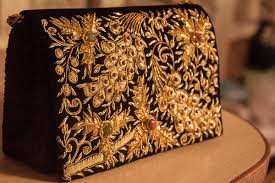Zari work or Jari, is an even thread made of fine gold or silver, used to make traditional Indian or Pakistani embroidered fabrics, through an intricate art of weaving threads.
zari work
Started during the Mughal era, Zari was introduced in India by the Haj pilgrims, where it was associated with the grand attires of Gods, Kings and literary figures.
The Zari embroidery is particularly famous in Lucknow, Bhopal, Hyderabad, Delhi, Agra, Kashmir, Mumbai, Ajmer and Chennai regions of India. While Surat in the state of Gujarat on the west coast of India is the world’s largest producer of all types of zari.
Zari making is also recognized as one of the ancient handicrafts by the government of India.

The dull zari thread is called Kora, and the shinier one is called Chikna, which not only increases the monetary value of the fabric, but also gives it a rich royal look.
Though, today in most fabrics, zari is not made of real gold and silver, but has cotton or polyester yarn at its core, wrapped by golden or silver metallic yarn, known as metallic zari. This metal embroidery threads have a uniform flexibility, evenness and ductility, along with the properties of resistance to rust, durability and light weight, as compared to the traditional zari thread.
Zari, though categorized as Real Zari, Imitation Zari and Metallic Zari, it is used in various forms such as Zardozi, Kataoki Bel, Mukaish, Tilla or Marori Work, Gota Work, Kinari Work.
The approximate price range of Real and Imitation Zari varies anywhere between Rs. 20000 to Rs. 150000 depending on the work needed, while for Metallic Zari, the price range is between Rs. 1500 to Rs. 12000.

If you are planning to spend so much to own these exquisite, stunning form of art, or you already own them, here are some tips you might find helpful, when it comes to your zari goods maintenance.
Since zari contains the weaves of gold and silver, the metal, especially the silver threads react to the atmospheric air and looks dull & old. To maintain its shine and newness, the best solution is to wrap them in soft cotton or a muslin dhoti, as this protects them from any reaction.
Dry cleaning is the best for Zari embroidered dresses, though if there is a need to wash these dresses, it should be done in mild soap water, then dry these in shade.
If you use naphthalene balls to keep the moths and silverfish away, don’t keep them in direct contact with your dresses, as they tend to discolour any zari work. A better option would be to use dry neem leaves as they have anti-pest and anti-fungal properties.
It is also advisable to avoid spraying perfumes or deodorants directly on these dresses.



